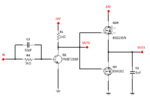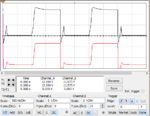mrinalmani
Advanced Member level 1
- Joined
- Oct 7, 2011
- Messages
- 463
- Helped
- 60
- Reputation
- 121
- Reaction score
- 58
- Trophy points
- 1,318
- Location
- Delhi, India
- Activity points
- 5,285
Hi
A 3.3V PWM input is stepped up to 12V using a BJT. The BJT has a speed up capacitor of 50pF. The output from the BJT is fed to an inverted push-pull stage. (Inverted as in the P MOSFET is at the bottom and N at the top)

The problem is that soon after the BJT switches ON, it immediately switches OFF for a few nano seconds and then switches ON again.
1. When the speed up capacitor is removed, there is no such problem.
2. Or when load capacitor is reduced to a small value, again the problem dissapears.
See the waveform of switching.
Black: Out1
Red: Out2

Why is the BJT turning off momentarily?
Thank you!
A 3.3V PWM input is stepped up to 12V using a BJT. The BJT has a speed up capacitor of 50pF. The output from the BJT is fed to an inverted push-pull stage. (Inverted as in the P MOSFET is at the bottom and N at the top)

The problem is that soon after the BJT switches ON, it immediately switches OFF for a few nano seconds and then switches ON again.
1. When the speed up capacitor is removed, there is no such problem.
2. Or when load capacitor is reduced to a small value, again the problem dissapears.
See the waveform of switching.
Black: Out1
Red: Out2

Why is the BJT turning off momentarily?
Thank you!